Aerodynamic Response and Running Posture Analysis When the Train Passes a Crosswind Region on a Bridge
Abstract
:1. Introduction
2. Methodology
2.1. Model Description
2.2. Numerical Method
2.3. Computational Domain and Boundary Conditions
2.4. Meshing Strategy
2.5. Parameter Definition
3. Validation
3.1. Grid Sensitivity Test
3.2. Experimental Validation
4. Results
4.1. Time-Varying Aerodynamic Coefficients
4.2. Flow Field and Train Surface Pressure
4.3. Dynamic Response
4.3.1. Derailment Coefficient
4.3.2. Wheel Load Reduction Rate
4.3.3. Running Posture
5. Conclusions
- Wind barriers of different heights provided significant changes to the train’s aerodynamic coefficients. The ends of the wind barrier essentially changed the local flow pattern, which is reflected in the obvious fluctuations in the aerodynamic coefficients when the train enters and exits the wind barrier, especially for the leaving. The running speed of the train gives a difference in the aerodynamic coefficient values instead of the developing pattern.
- The maximum Derailment coefficient continued to decrease with the increase in the height of wind barriers, which hardly affected the wheel load reduction rate. The fluctuation range and maximum value of the Derailment coefficient and the wheel load reduction rate of the first wheel increased with the train speed.
- For a general high-speed train running on a bridge in the crosswind, the 4 m high wind barrier was proven to effectively protect the running posture of the train, while the 6 m high one consistently exhibited over-protection. The 2 m high wind barrier had no apparent influence on the train’s posture.
- Further work may lie in the optimization of the severe aerodynamic changes and safety threats of the train passing by the wind barrier ends. It may be achieved by adding a longitudinally extended transition wall at the ends.
Author Contributions
Funding
Acknowledgments
Conflicts of Interest
References
- Guo, Z.; Liu, T.; Chen, Z.; Xia, Y.; Li, W.; Li, L. Aerodynamic influences of bogie’s geometric complexity on high-speed trains under crosswind. J. Wind. Eng. Ind. Aerodyn. 2020, 196, 104053. [Google Scholar] [CrossRef]
- Deng, E.; Yang, W.; He, X.; Ye, Y.; Zhu, Z.; Wang, A. Transient aerodynamic performance of high-speed trains when passing through an infrastructure consisting of tunnel–bridge–tunnel under crosswind. Tunn. Undergr. Space Technol. 2020, 102, 103440. [Google Scholar] [CrossRef]
- Guo, Z.; Liu, T.; Chen, Z.; Liu, Z.; Monzer, A.; Sheridan, J. Study of the flow around railway embankment of different heights with and without trains. J. Wind. Eng. Ind. Aerodyn. 2020, 202, 104203. [Google Scholar] [CrossRef]
- Gallagher, M.; Morden, J.; Baker, C.; Soper, D.; Quinn, A.; Hemida, H.; Sterling, M. Trains in crosswinds—Comparison of full-scale on-train measurements, physical model tests and CFD calculations. J. Wind. Eng. Ind. Aerodyn. 2018, 175, 428–444. [Google Scholar] [CrossRef] [Green Version]
- Yang, W.; Deng, E.; Zhu, Z.; He, X.; Wang, Y. Deterioration of dynamic response during high-speed train travelling in tunnel–bridge–tunnel scenario under crosswinds. Tunn. Undergr. Space Technol. 2020, 106, 103627. [Google Scholar] [CrossRef]
- Diedrichs, B.; Sima, M.; Orellano, A.; Tengstrand, H. Crosswind stability of a high-speed train on a high embankment. Proc. Inst. Mech. Eng. Part F J. Rail Rapid Transit 2007, 221, 205–225. [Google Scholar] [CrossRef]
- Noguchi, Y.; Suzuki, M.; Baker, C.; Nakade, K. Numerical and experimental study on the aerodynamic force coefficients of railway vehicles on an embankment in crosswind. J. Wind. Eng. Ind. Aerodyn. 2019, 184, 90–105. [Google Scholar] [CrossRef]
- Barcala, A.M.; Meseguer, J. An experimental study of the influence of parapets on the aerodynamic loads under cross wind on a two-dimensional model of a railway vehicle on a bridge. Proc. Inst. Mech. Eng. Part F J. Rail Rapid Transit 2007, 221, 487–494. [Google Scholar] [CrossRef]
- Xia, H.; Guo, W.; Zhang, N.; Sun, G. Dynamic analysis of a train–bridge system under wind action. Comput. Struct. 2008, 86, 1845–1855. [Google Scholar] [CrossRef]
- Song, M.-K.; Noh, H.-C.; Choi, C.-K. A new three-dimensional finite element analysis model of high-speed train–bridge interactions. Eng. Struct. 2003, 25, 1611–1626. [Google Scholar] [CrossRef]
- Kozmar, H.; Procino, L.; Borsani, A.; Bartoli, G. Sheltering efficiency of wind barriers on bridges. J. Wind. Eng. Ind. Aerodyn. 2012, 107–108, 274–284. [Google Scholar] [CrossRef] [Green Version]
- Bitog, J.; Lee, I.-B.; Shin, M.-H.; Hong, S.-W.; Hwang, H.-S.; Seo, I.-H.; Yoo, J.-I.; Kwon, K.-S.; Kim, Y.-H.; Han, J.-W. Numerical simulation of an array of fences in Saemangeum reclaimed land. Atmospheric Environ. 2009, 43, 4612–4621. [Google Scholar] [CrossRef]
- Hong, S.-W.; Lee, I.-B.; Seo, I.-H. Modelling and predicting wind velocity patterns for windbreak fence design. J. Wind. Eng. Ind. Aerodyn. 2015, 142, 53–64. [Google Scholar] [CrossRef]
- Chen, N.; Li, Y.; Wang, B.; Su, Y.; Xiang, H. Effects of wind barrier on the safety of vehicles driven on bridges. J. Wind. Eng. Ind. Aerodyn. 2015, 143, 113–127. [Google Scholar] [CrossRef]
- Xue, F.; Han, Y.; Zou, Y.; He, X.; Chen, S. Effects of wind-barrier parameters on dynamic responses of wind-road vehicle–bridge system. J. Wind. Eng. Ind. Aerodyn. 2020, 206, 104367. [Google Scholar] [CrossRef]
- Gu, H.; Liu, T.; Jiang, Z.; Guo, Z. Research on the wind-sheltering performance of different forms of corrugated wind barriers on railway bridges. J. Wind. Eng. Ind. Aerodyn. 2020, 201, 104166. [Google Scholar] [CrossRef]
- Deng, E.; Yang, W.; He, X.; Zhu, Z.; Wang, H.; Wang, Y.; Wang, A.; Zhou, L. Aerodynamic response of high-speed trains under crosswind in a bridge-tunnel section with or without a wind barrier. J. Wind. Eng. Ind. Aerodyn. 2021, 210, 104502. [Google Scholar] [CrossRef]
- Deng, E.; Yang, W.; Lei, M.; Zhu, Z.; Zhang, P. Aerodynamic loads and traffic safety of high-speed trains when passing through two windproof facilities under crosswind: A comparative study. Eng. Struct. 2019, 188, 320–339. [Google Scholar] [CrossRef]
- Chu, C.-R.; Chang, C.-Y.; Huang, C.-J.; Wu, T.-R.; Wang, C.-Y.; Liu, M.-Y. Windbreak protection for road vehicles against crosswind. J. Wind. Eng. Ind. Aerodyn. 2013, 116, 61–69. [Google Scholar] [CrossRef]
- He, X.; Zou, Y.; Wang, H.; Han, Y.; Shi, K. Aerodynamic characteristics of a trailing rail vehicles on viaduct based on still wind tunnel experiments. J. Wind. Eng. Ind. Aerodyn. 2014, 135, 22–33. [Google Scholar] [CrossRef]
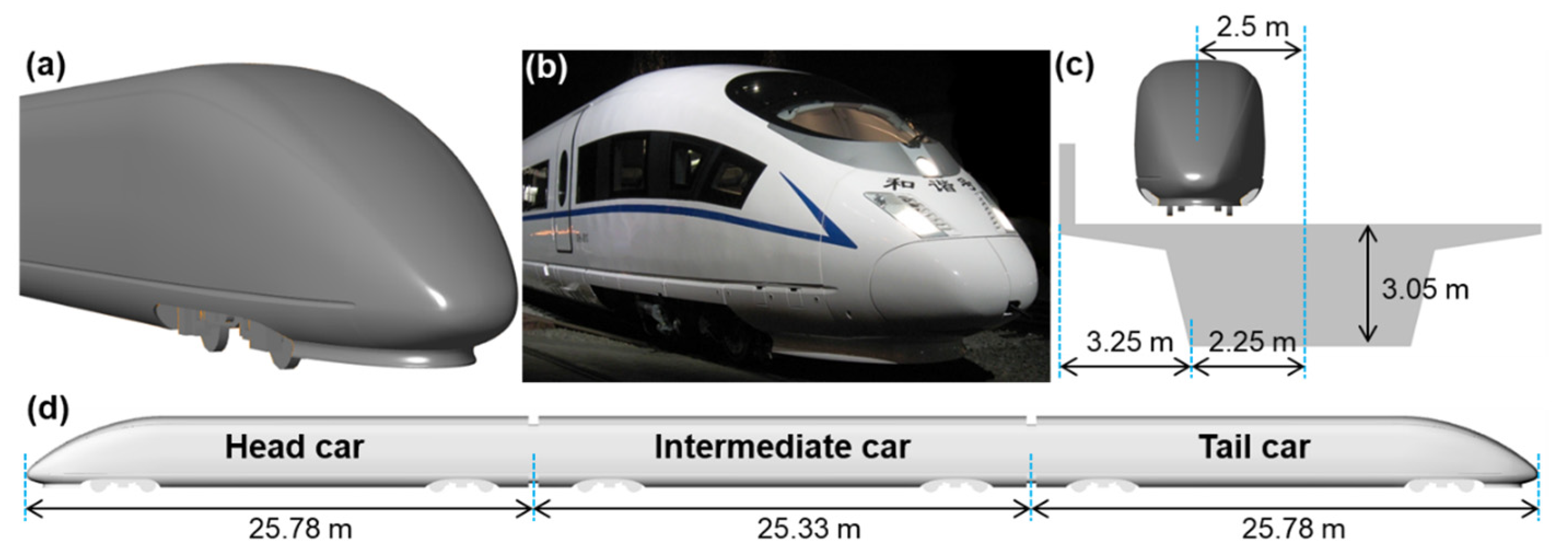
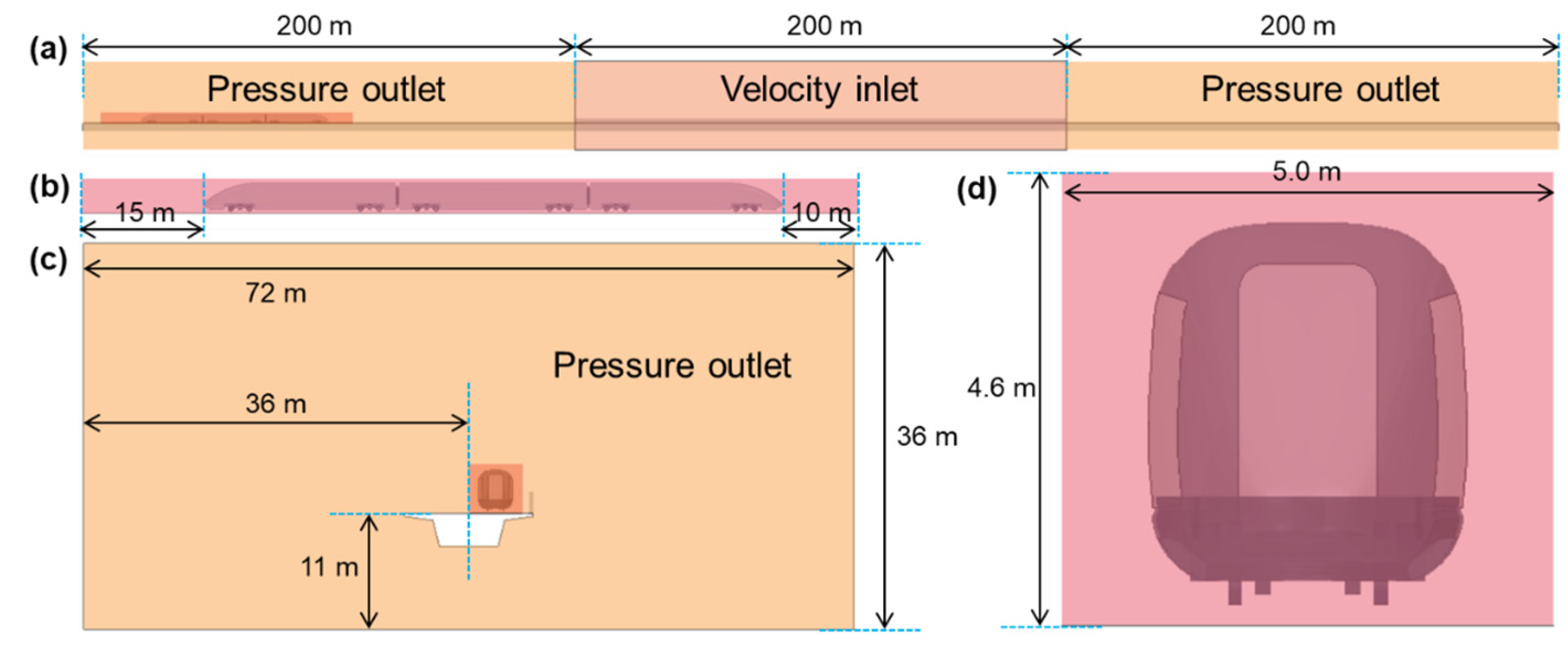
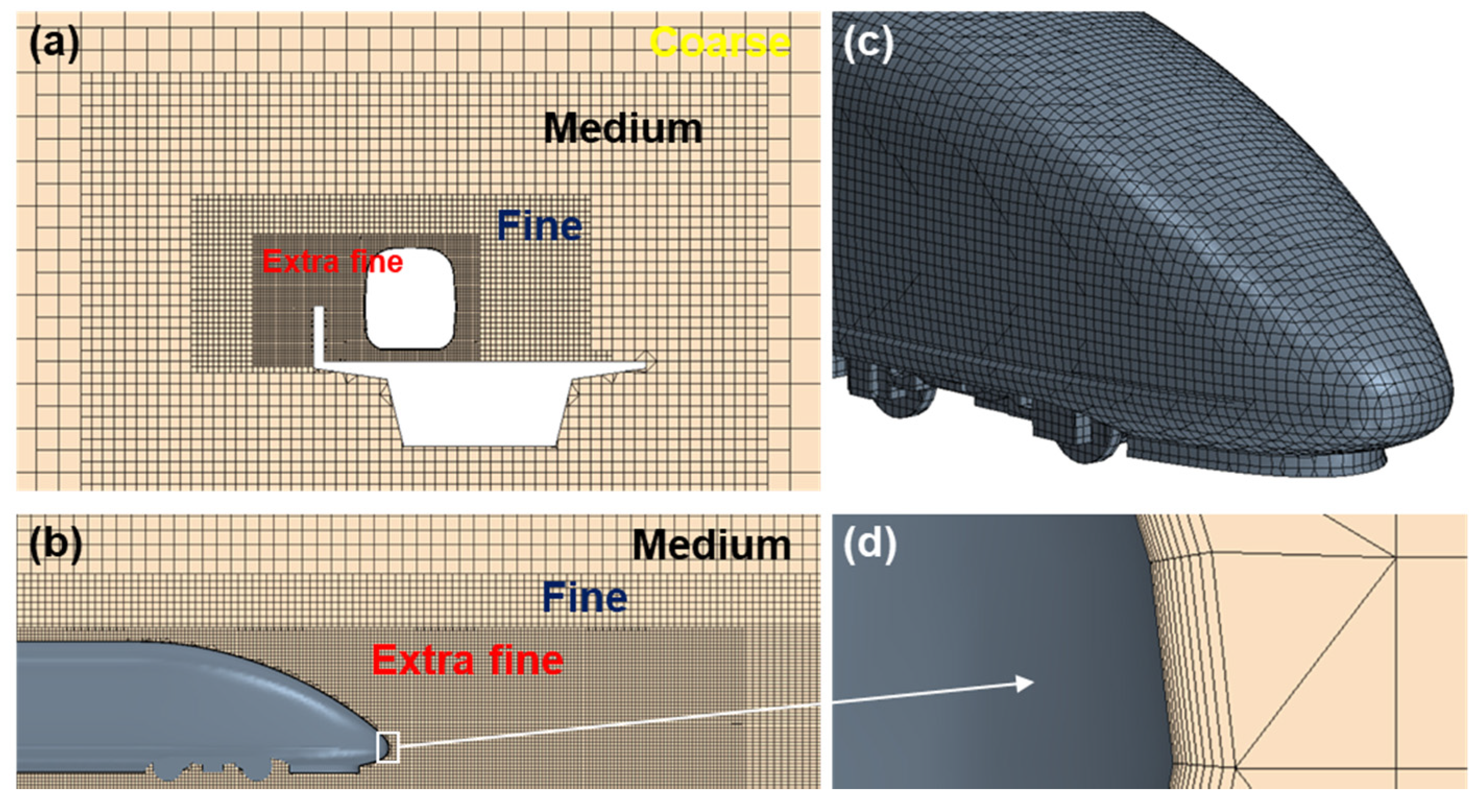

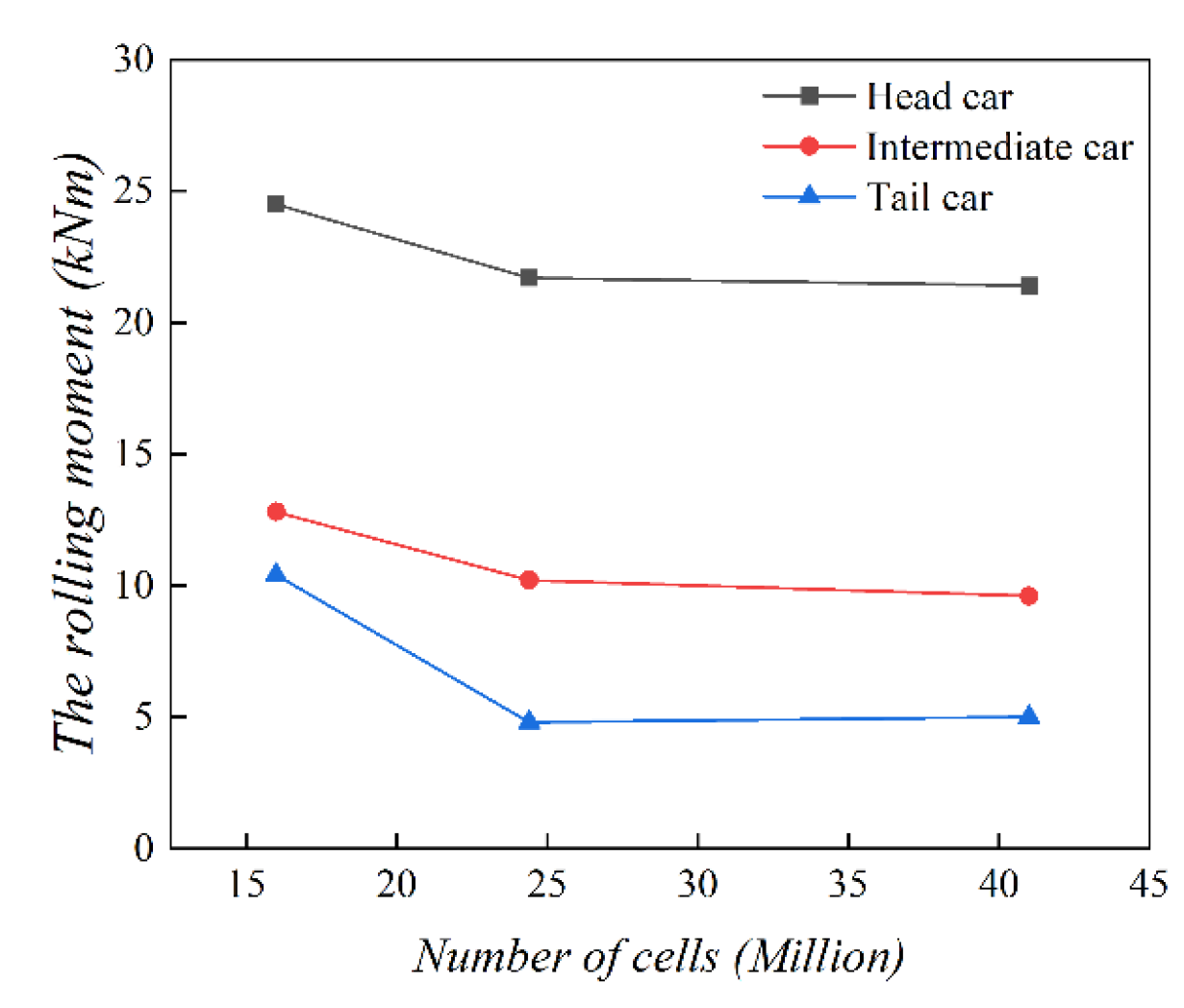
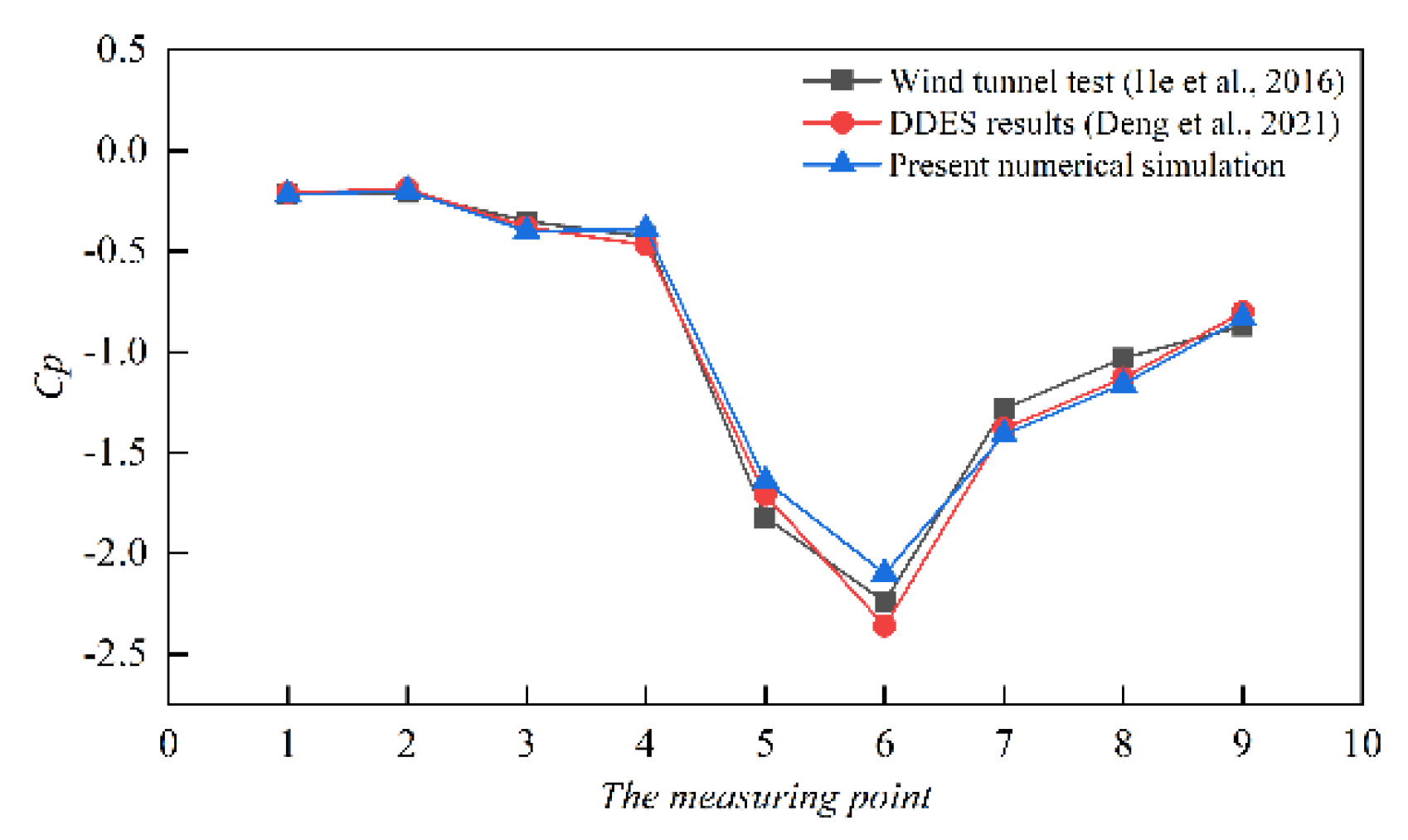
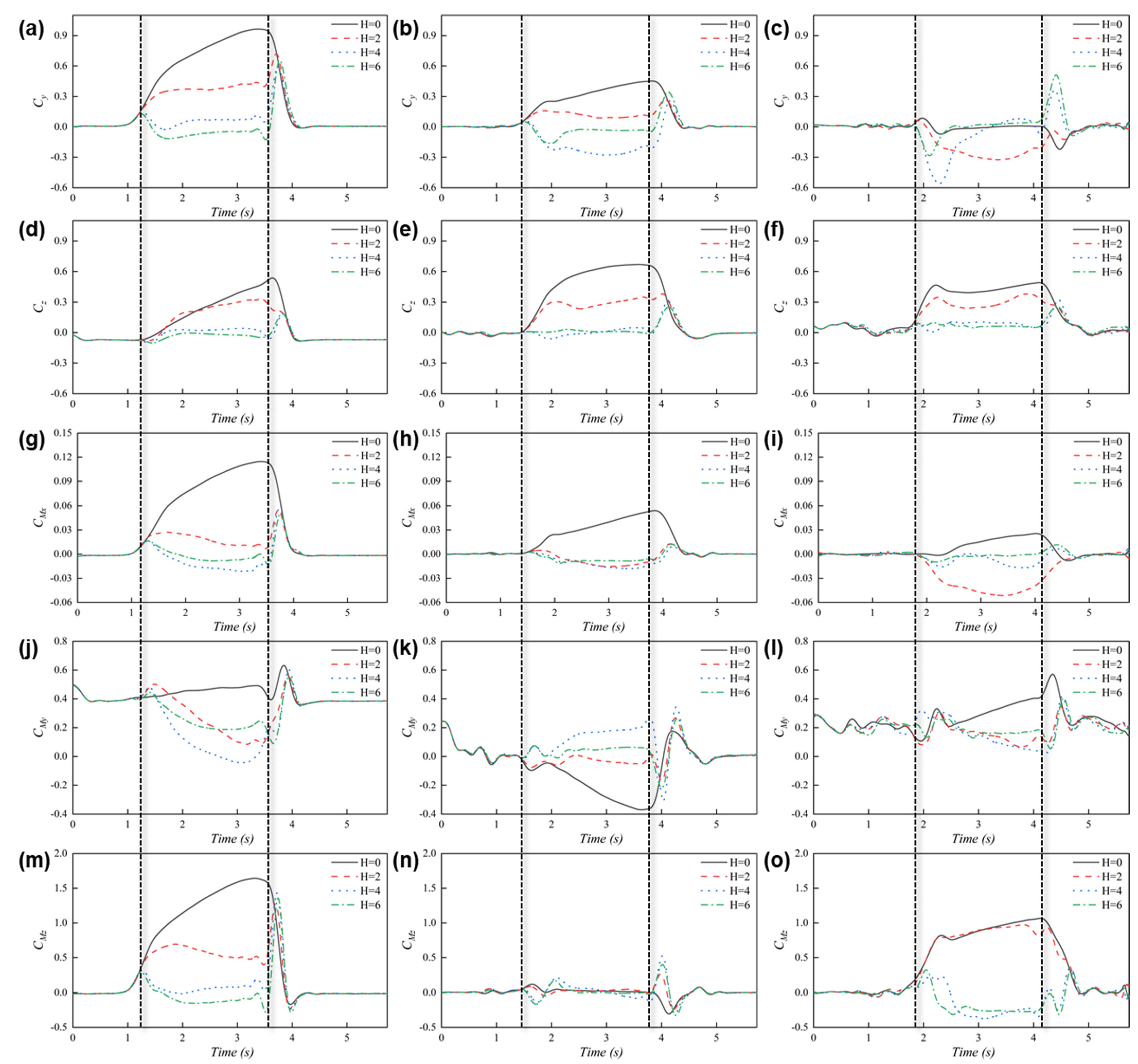
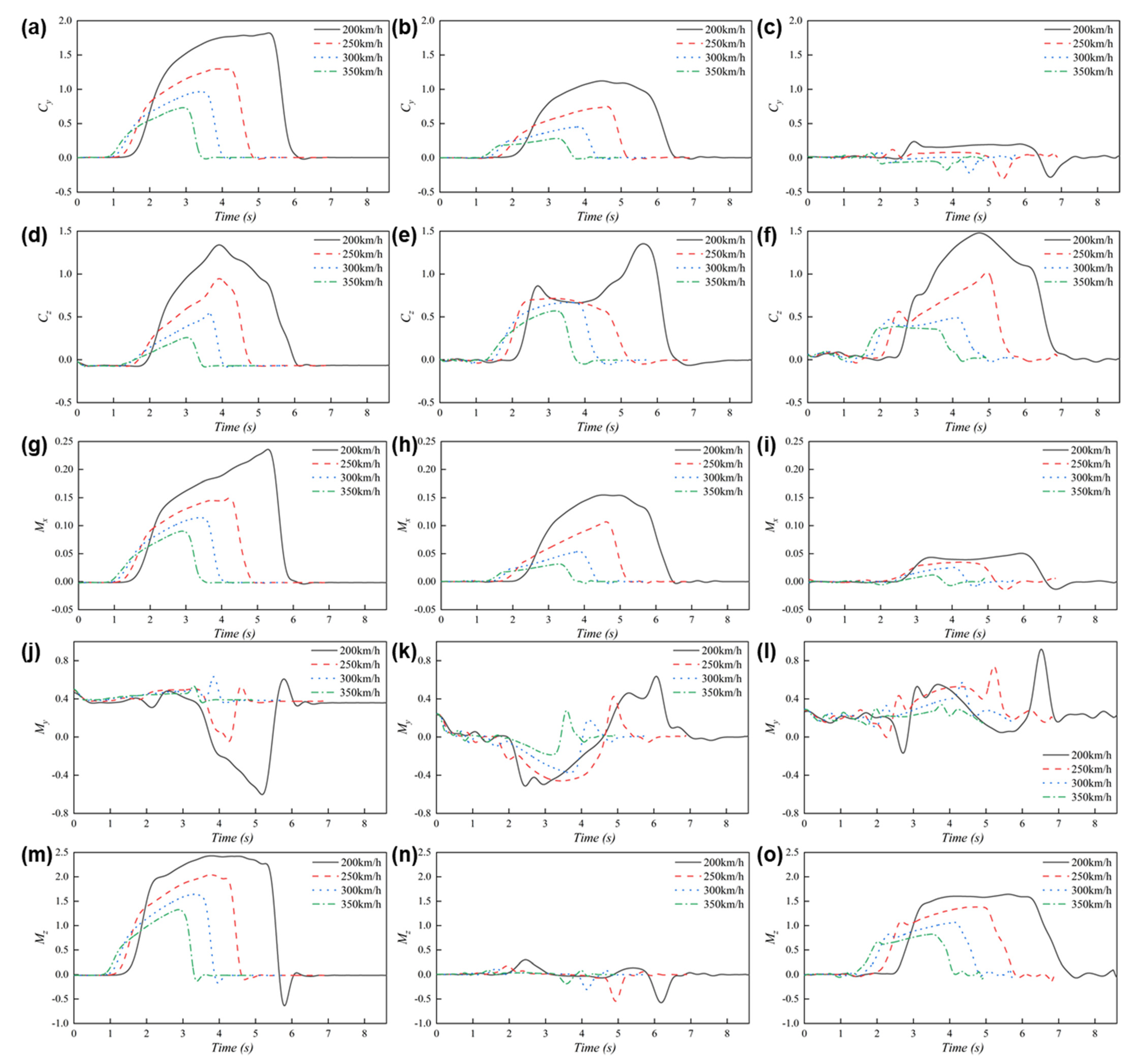


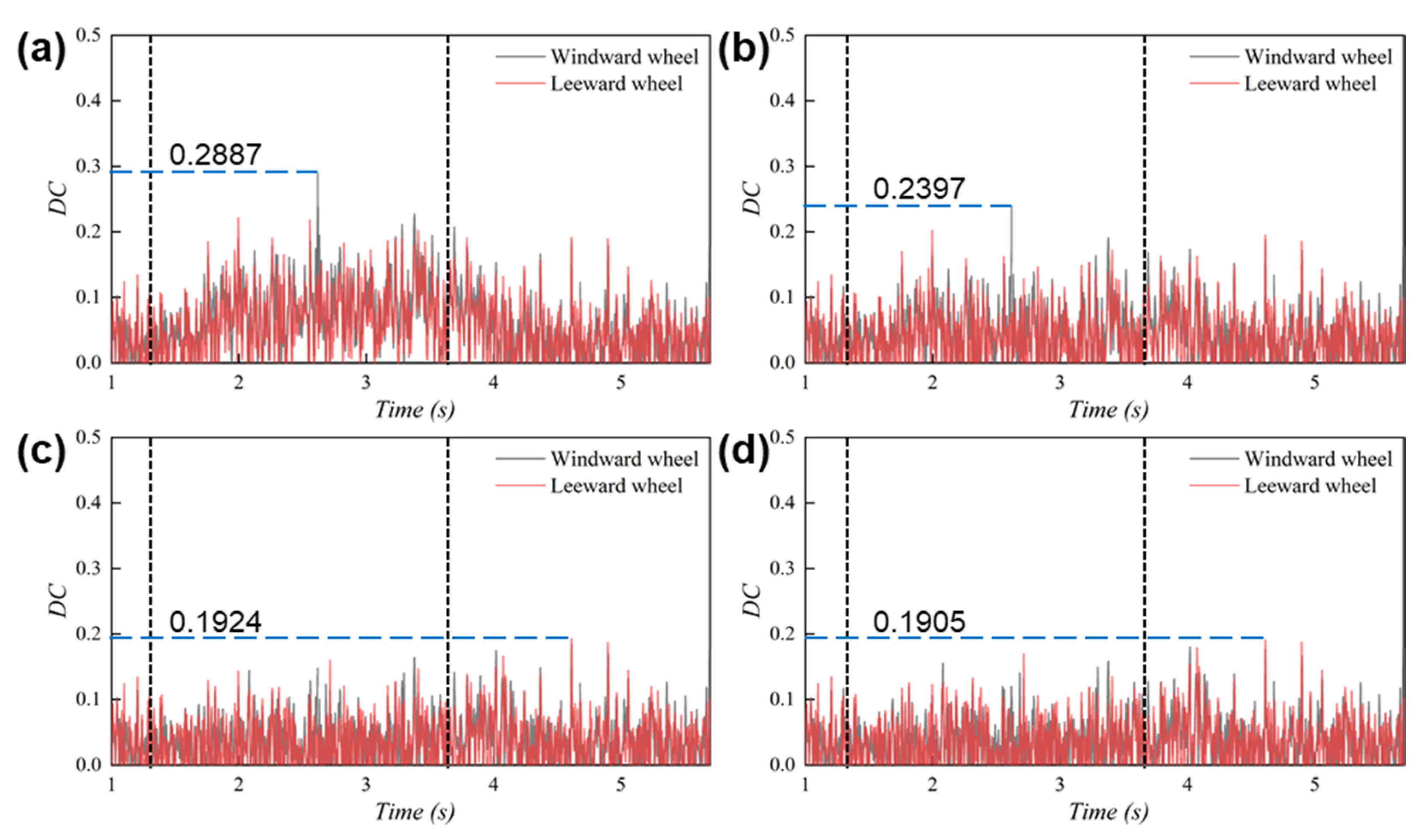
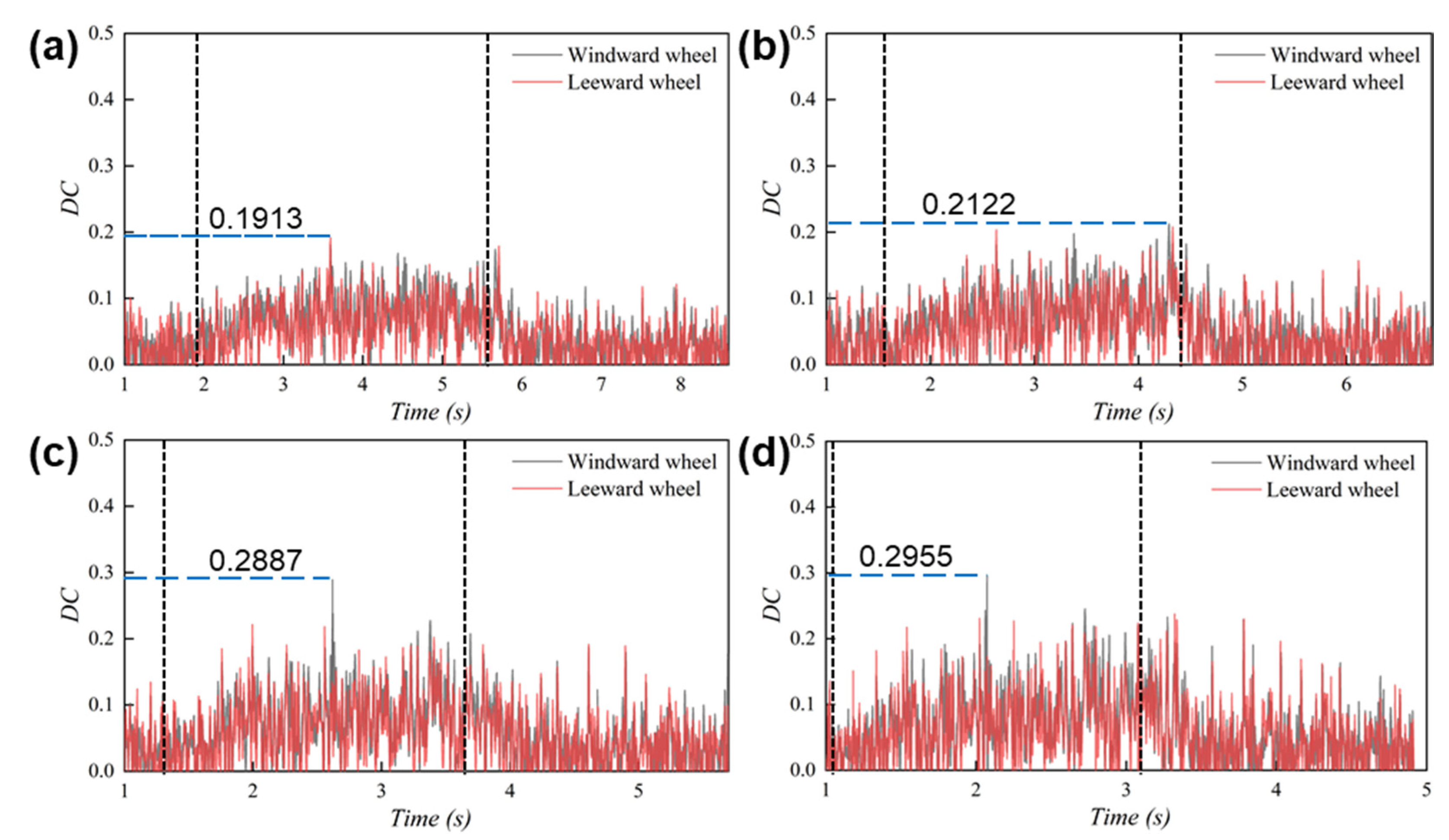

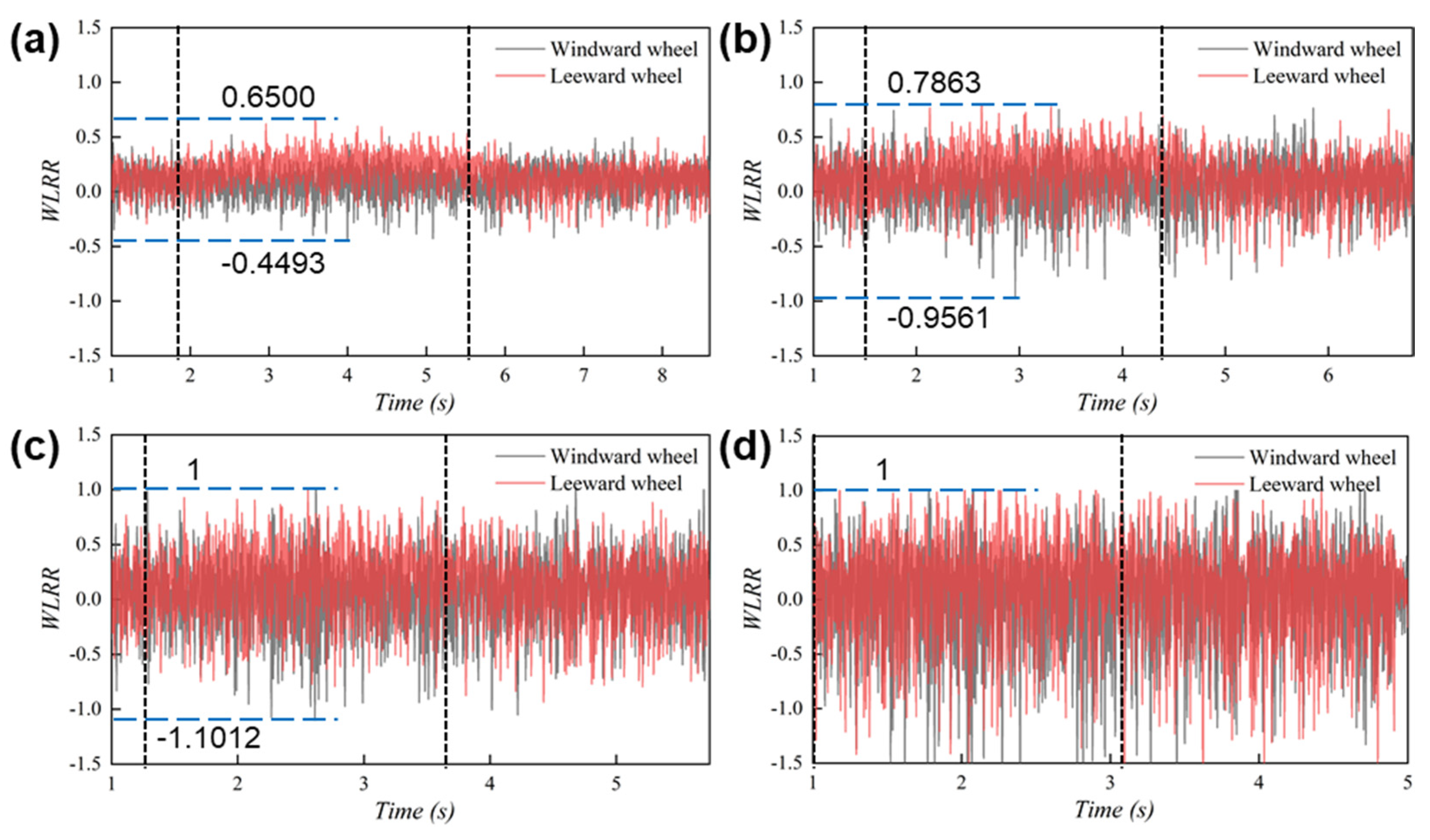
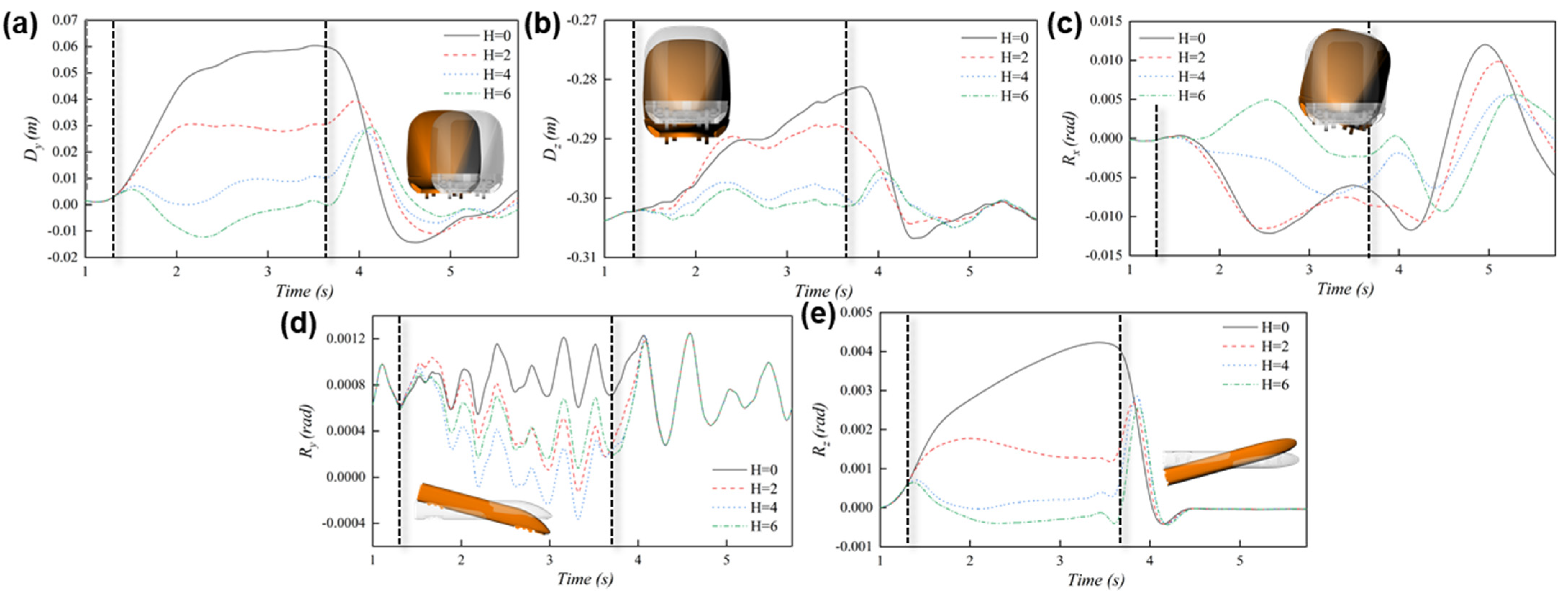
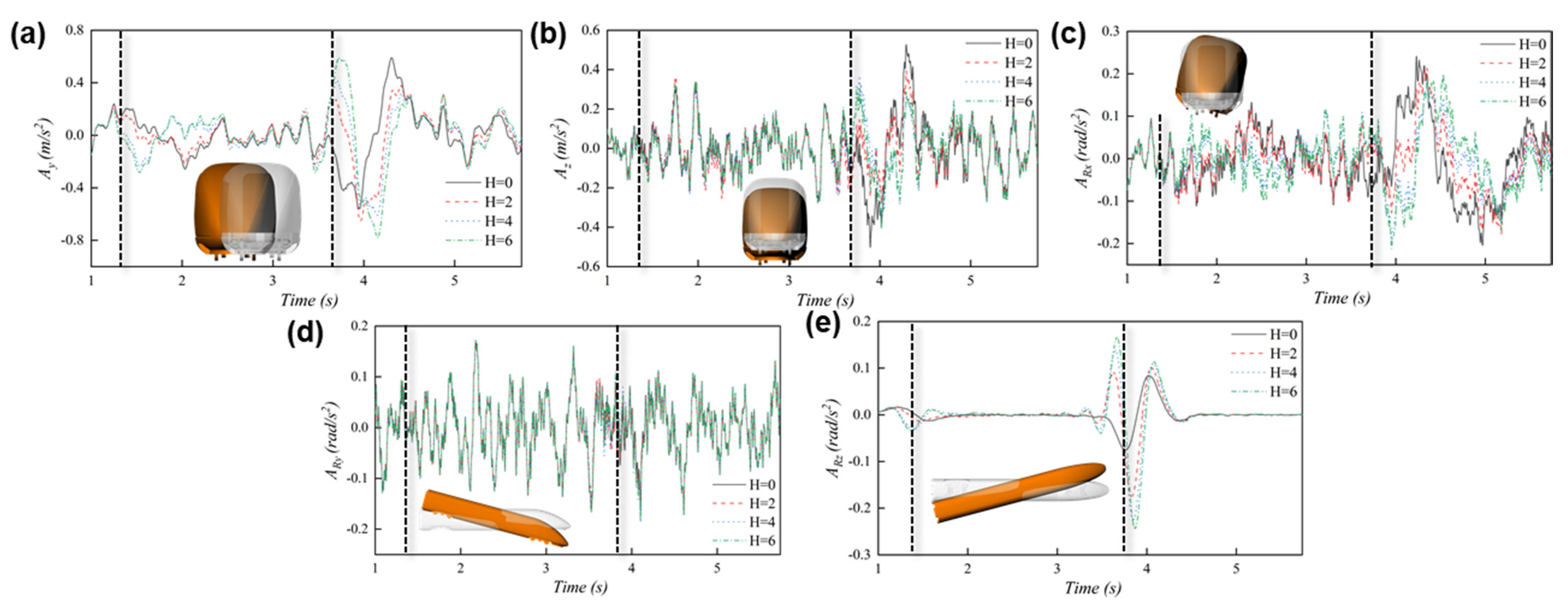
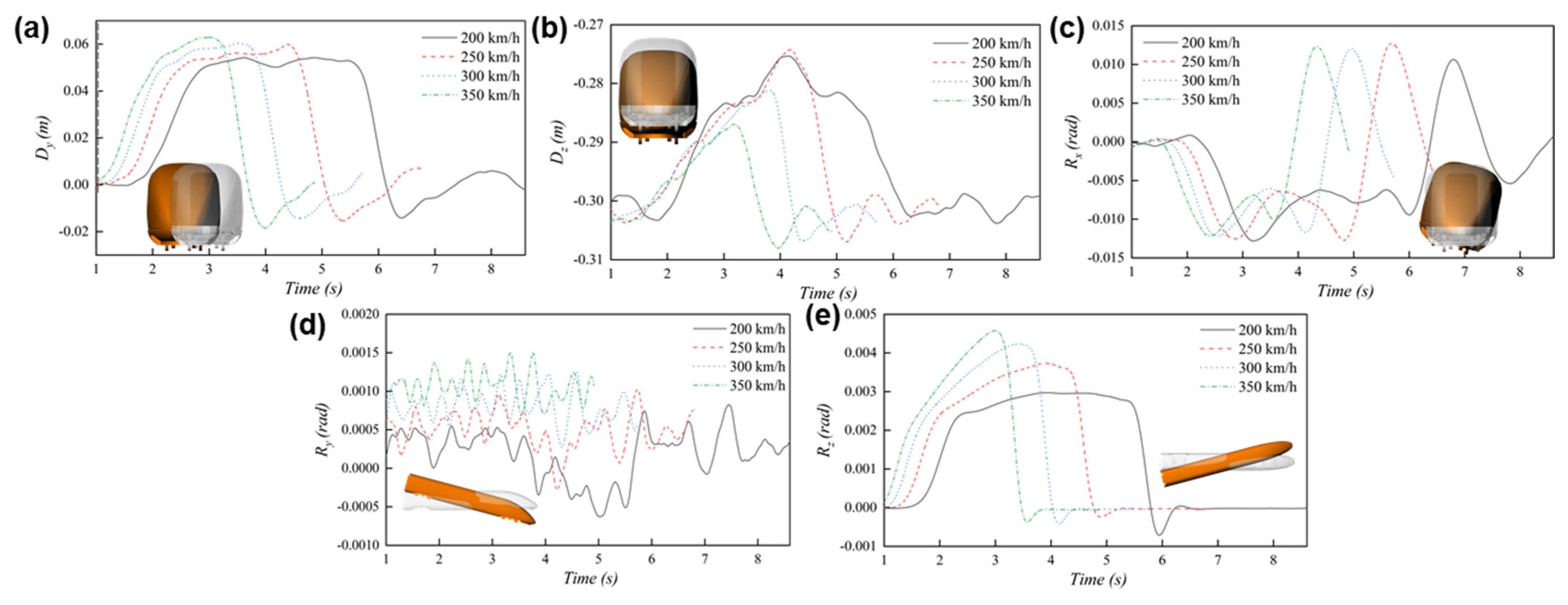
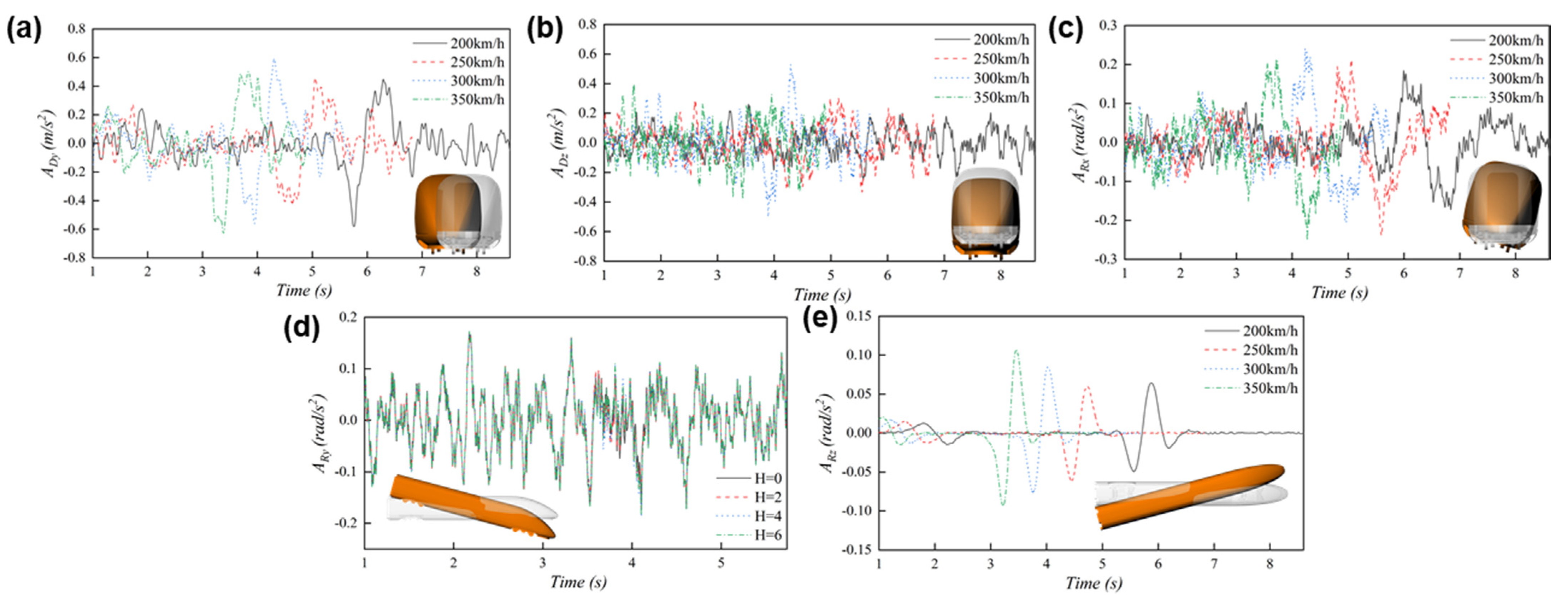
| Coefficient | Car | Entering | Exiting | ||||||
|---|---|---|---|---|---|---|---|---|---|
| H = 0 m | H = 2 m | H = 4 m | H = 6 m | H = 0 m | H = 2 m | H = 4 m | H = 6 m | ||
| Head | 0.441 | 0.279 | 0.157 | 0.228 | 0.925 | 0.661 | 0.544 | 0.787 | |
| Intermediate | 0.219 | 0.127 | 0.241 | 0.204 | 0.426 | 0.226 | 0.460 | 0.393 | |
| Tail | 0.137 | 0.221 | 0.552 | 0.309 | 0.226 | 0.169 | 0.433 | 0.513 | |
| Head | 0.092 | 0.079 | 0.076 | 0.033 | 0.574 | 0.342 | 0.244 | 0.231 | |
| Intermediate | 0.370 | 0.275 | 0.065 | 0.009 | 0.606 | 0.298 | 0.313 | 0.249 | |
| Tail | 0.419 | 0.312 | 0.074 | 0.081 | 0.393 | 0.227 | 0.270 | 0.196 | |
| Head | 0.050 | 0.022 | 0.017 | 0.011 | 0.110 | 0.049 | 0.073 | 0.064 | |
| Intermediate | 0.022 | 0.004 | 0.005 | 0.007 | 0.047 | 0.021 | 0.021 | 0.019 | |
| Tail | 0.002 | 0.030 | 0.015 | 0.012 | 0.032 | 0.028 | 0.015 | 0.010 | |
| Head | 0.014 | 0.097 | 0.137 | 0.075 | 0.238 | 0.453 | 0.474 | 0.462 | |
| Intermediate | 0.096 | 0.078 | 0.092 | 0.084 | 0.532 | 0.435 | 0.649 | 0.481 | |
| Tail | 0.223 | 0.198 | 0.170 | 0.124 | 0.331 | 0.256 | 0.392 | 0.352 | |
| Head | 0.772 | 0.515 | 0.255 | 0.283 | 1.780 | 1.509 | 1.668 | 1.644 | |
| Intermediate | 0.116 | 0.134 | 0.184 | 0.215 | 0.305 | 0.504 | 0.830 | 0.729 | |
| Tail | 0.678 | 0.703 | 0.158 | 0.409 | 0.655 | 0.490 | 0.637 | 0.527 | |
| Coefficient | Car | Entering | Exiting | ||||||
|---|---|---|---|---|---|---|---|---|---|
| 200 km/h | 250 km/h | 300 km/h | 350 km/h | 200 km/h | 250 km/h | 300 km/h | 350 km/h | ||
| Head | 0.993 | 0.653 | 0.441 | 0.312 | 1.744 | 1.222 | 0.925 | 0.723 | |
| Intermediate | 0.604 | 0.314 | 0.219 | 0.097 | 0.852 | 0.693 | 0.426 | 0.279 | |
| Tail | 0.206 | 0.126 | 0.137 | 0.099 | 0.417 | 0.329 | 0.226 | 0.122 | |
| Head | 0.603 | 0.227 | 0.092 | 0.041 | 0.830 | 0.882 | 0.574 | 0.324 | |
| Intermediate | 0.790 | 0.633 | 0.370 | 0.092 | 1.253 | 0.484 | 0.606 | 0.533 | |
| Tail | 0.649 | 0.500 | 0.419 | 0.325 | 0.951 | 0.914 | 0.393 | 0.253 | |
| Head | 0.111 | 0.075 | 0.050 | 0.034 | 0.233 | 0.142 | 0.110 | 0.086 | |
| Intermediate | 0.069 | 0.032 | 0.022 | 0.005 | 0.117 | 0.094 | 0.047 | 0.029 | |
| Tail | 0.038 | 0.013 | 0.002 | 0.004 | 0.055 | 0.037 | 0.032 | 0.019 | |
| Head | 0.098 | 0.019 | 0.014 | 0.019 | 1.112 | 0.579 | 0.238 | 0.132 | |
| Intermediate | 0.347 | 0.193 | 0.096 | 0.062 | 0.508 | 0.520 | 0.532 | 0.460 | |
| Tail | 0.699 | 0.438 | 0.223 | 0.156 | 0.717 | 0.485 | 0.331 | 0.111 | |
| Head | 1.555 | 1.117 | 0.772 | 0.562 | 2.902 | 2.063 | 1.780 | 1.425 | |
| Intermediate | 0.167 | 0.119 | 0.116 | 0.060 | 0.597 | 0.485 | 0.305 | 0.199 | |
| Tail | 1.267 | 0.993 | 0.678 | 0.517 | 1.029 | 0.837 | 0.655 | 0.499 | |
Publisher’s Note: MDPI stays neutral with regard to jurisdictional claims in published maps and institutional affiliations. |
© 2021 by the authors. Licensee MDPI, Basel, Switzerland. This article is an open access article distributed under the terms and conditions of the Creative Commons Attribution (CC BY) license (https://creativecommons.org/licenses/by/4.0/).
Share and Cite
Yan, J.; Chen, T.; Deng, E.; Yang, W.; Cheng, S.; Zhang, B. Aerodynamic Response and Running Posture Analysis When the Train Passes a Crosswind Region on a Bridge. Appl. Sci. 2021, 11, 4126. https://doi.org/10.3390/app11094126
Yan J, Chen T, Deng E, Yang W, Cheng S, Zhang B. Aerodynamic Response and Running Posture Analysis When the Train Passes a Crosswind Region on a Bridge. Applied Sciences. 2021; 11(9):4126. https://doi.org/10.3390/app11094126
Chicago/Turabian StyleYan, Jian, Tefang Chen, E Deng, Weichao Yang, Shu Cheng, and Biming Zhang. 2021. "Aerodynamic Response and Running Posture Analysis When the Train Passes a Crosswind Region on a Bridge" Applied Sciences 11, no. 9: 4126. https://doi.org/10.3390/app11094126






